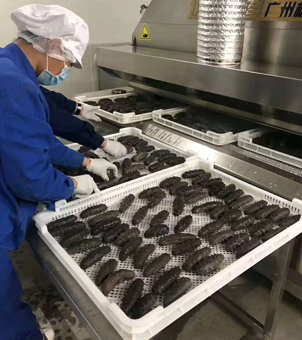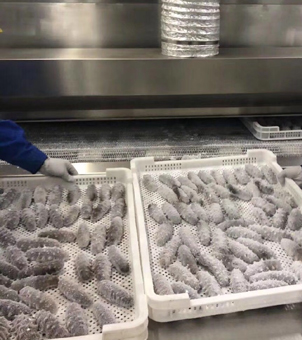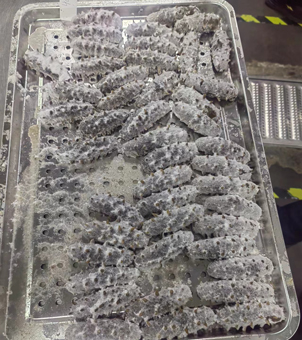In food processing and cold chain logistics, freezing equipment plays a vital role in preserving product quality. As technology evolves, liquid nitrogen freezers have gained attention and are increasingly used in scenarios where freezing speed and product quality are critical. But how exactly do they differ from traditional freezers?
As a professional dedicated to the development and application of cryogenic freezing equipment, I’ll walk you through the key differences between liquid nitrogen and traditional freezers—from their cooling principles to their application value—so you can make a more informed choice for your business.
1. Cooling Principles: Two Different Systems
Liquid Nitrogen Freezer
This system uses direct liquid nitrogen spray to rapidly reduce temperature. Liquid nitrogen is an ultra-cold medium (-196°C) that instantly absorbs heat upon contact with the product.
Cooling medium: Liquid nitrogen (physical cooling, no compressor)
Cooling method: Direct or indirect contact with the product
Cooling speed: Extremely fast (freezing within minutes)
Traditional Freezer
These systems rely on mechanical refrigeration cycles (compressor + condenser + evaporator) using refrigerants like Freon, ammonia, or CO₂ to transfer heat.
Cooling medium: Freon, ammonia, CO₂
Cooling method: Air-based or contact-based cooling (plate, air circulation)
Cooling speed: Slower (hours to freeze core)
Liquid nitrogen is a physical cooling method, while traditional systems are mechanical cooling systems.
2. Freezing Speed: Lock Freshness vs. Gradual Cooling
Speed is where liquid nitrogen shines. It can lower the core temperature of food to below −18°C within minutes, significantly reducing the time for ice crystal formation and locking in moisture and nutrients.
Traditional freezers take longer, resulting in large ice crystals that can damage cell membranes—causing nutrient loss and affecting texture. This makes a significant difference when freezing premium items like sea cucumbers, abalone, oysters, or Wagyu beef.
3. Food Quality: Micro Ice Crystals vs. Structural Damage
Liquid nitrogen creates uniform, micro-sized ice crystals that do not rupture cell structures. Upon thawing, the product retains its original texture, appearance, and taste.
In contrast, traditional freezing often results in:
Cell membrane rupture
Surface frost buildup
Severe water loss after thawing
Noticeable loss of flavor and mouthfeel
For high-value or delicate products, LN₂ freezing better preserves original quality.
4. Energy Performance: Targeted Efficiency vs. Continuous Consumption
Liquid Nitrogen Freezers don’t require compressors or refrigerant systems. Their energy consumption mainly comes from LN₂ usage. While producing LN₂ requires electricity, the cooling efficiency per unit is high, making it ideal for short-batch or high-precision freezing.
Traditional Freezers rely heavily on electricity and operate continuously, which increases energy costs over time—especially in bulk storage environments.
LN₂ freezers are perfect for high-value, precision freezing, while traditional systems work better for bulk cold storage.
5. Application Scenarios: Flash Freezing vs. Mass Storage
| Freezing Method | Best For | Typical Use Cases |
| Liquid Nitrogen | Premium seafood, meat, baked goods | Seafood processing, fresh food factories, premium kitchens |
| Traditional Freezer | Common meat, vegetables, frozen snacks | Supermarket storage, industrial cold rooms |
LN₂ is focused on locking freshness quickly, while traditional systems focus on long-term preservation.


6. Environmental & Safety Comparison: Clean Nitrogen vs. Synthetic Refrigerants
Liquid nitrogen is a naturally occurring component of the atmosphere. It is:
Non-toxic
Odorless
Non-flammable
Does not harm the ozone layer or release greenhouse gases
In contrast, many refrigerants used in traditional freezers (e.g., Freon) can contribute to global warming or ozone depletion. The gas released from LN₂ systems is simply nitrogen gas—returning safely to the atmosphere.
7. Equipment Size & Maintenance
LN₂ Freezers are compact, require less space, and are simpler to maintain (no compressors or complicated piping).
Traditional Freezers are larger and often involve complex installation and higher maintenance—especially for large cold storage systems.
LN₂ equipment is more suitable for businesses with limited space or flexible deployment needs.
8. Cost Comparison: Equipment vs. Operation
| Factor | Liquid Nitrogen Freezer | Traditional Freezer |
| Initial Investment | Slightly higher | Moderate |
| Daily Operating Cost | Based on LN₂ usage (controllable) | Electricity-dependent |
| Maintenance Cost | Low | Medium to high (based on compressor life) |
| Cost-Effectiveness | Low for high-precision operations | Better for large-scale storage |
9. Which Freezing Method Is Right for You?
Consider LN₂ freezing if you:
Need maximum freshness retention
Require fast freezing times
Want to maintain product appearance and nutrition
Are handling premium or export food products
Choose traditional freezing if you:
Focus on large-volume storage
Want to control operational costs
Are dealing with general food preservation needs
Liquid nitrogen freezing isn’t meant to replace all traditional systems—it complements them as an advanced, targeted solution in industries like seafood processing, prepared meals, functional food exports, and premium frozen meals.
A Smarter Way to Freeze
Liquid nitrogen freezing represents the future of high-efficiency, eco-friendly, precision cold chain solutions. As a trusted cryogenic equipment manufacturer, SPEEDCRYO is dedicated to helping companies transition from traditional to intelligent freezing systems.
If you’re considering integrating LN₂ freezing into your production, feel free to contact us. We offer:
Free cold chain process consultation
Site layout planning
Tailored equipment recommendations & ROI analysis
